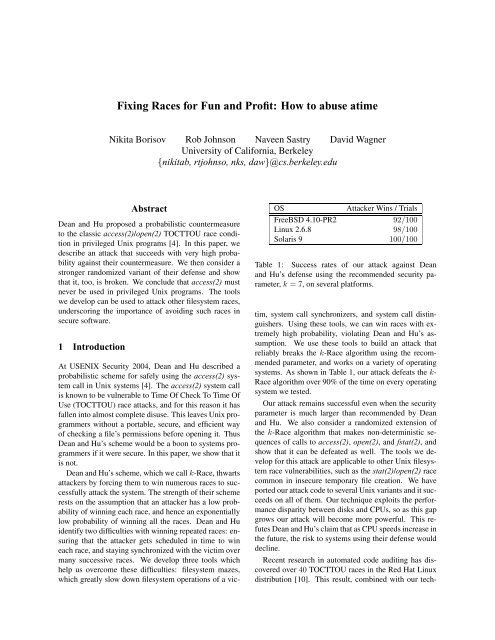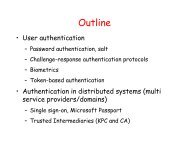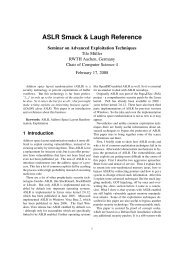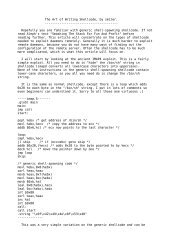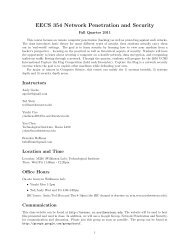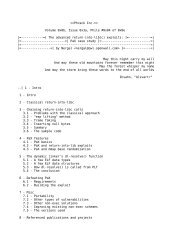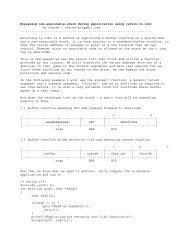Fixing Races for Fun and Profit: How to abuse atime - University of ...
Fixing Races for Fun and Profit: How to abuse atime - University of ...
Fixing Races for Fun and Profit: How to abuse atime - University of ...
Create successful ePaper yourself
Turn your PDF publications into a flip-book with our unique Google optimized e-Paper software.
<strong>Fixing</strong> <strong>Races</strong> <strong>for</strong> <strong>Fun</strong> <strong>and</strong> <strong>Pr<strong>of</strong>it</strong>: <strong>How</strong> <strong>to</strong> <strong>abuse</strong> <strong>atime</strong><br />
Nikita Borisov Rob Johnson Naveen Sastry David Wagner<br />
<strong>University</strong> <strong>of</strong> Cali<strong>for</strong>nia, Berkeley<br />
{nikitab, rtjohnso, nks, daw}@cs.berkeley.edu<br />
Abstract<br />
Dean <strong>and</strong> Hu proposed a probabilistic countermeasure<br />
<strong>to</strong> the classic access(2)/open(2) TOCTTOU race condition<br />
in privileged Unix programs [4]. In this paper, we<br />
describe an attack that succeeds with very high probability<br />
against their countermeasure. We then consider a<br />
stronger r<strong>and</strong>omized variant <strong>of</strong> their defense <strong>and</strong> show<br />
that it, <strong>to</strong>o, is broken. We conclude that access(2) must<br />
never be used in privileged Unix programs. The <strong>to</strong>ols<br />
we develop can be used <strong>to</strong> attack other filesystem races,<br />
underscoring the importance <strong>of</strong> avoiding such races in<br />
secure s<strong>of</strong>tware.<br />
1 Introduction<br />
At USENIX Security 2004, Dean <strong>and</strong> Hu described a<br />
probabilistic scheme <strong>for</strong> safely using the access(2) system<br />
call in Unix systems [4]. The access(2) system call<br />
is known <strong>to</strong> be vulnerable <strong>to</strong> Time Of Check To Time Of<br />
Use (TOCTTOU) race attacks, <strong>and</strong> <strong>for</strong> this reason it has<br />
fallen in<strong>to</strong> almost complete disuse. This leaves Unix programmers<br />
without a portable, secure, <strong>and</strong> efficient way<br />
<strong>of</strong> checking a file’s permissions be<strong>for</strong>e opening it. Thus<br />
Dean <strong>and</strong> Hu’s scheme would be a boon <strong>to</strong> systems programmers<br />
if it were secure. In this paper, we show that it<br />
is not.<br />
Dean <strong>and</strong> Hu’s scheme, which we call k-Race, thwarts<br />
attackers by <strong>for</strong>cing them <strong>to</strong> win numerous races <strong>to</strong> successfully<br />
attack the system. The strength <strong>of</strong> their scheme<br />
rests on the assumption that an attacker has a low probability<br />
<strong>of</strong> winning each race, <strong>and</strong> hence an exponentially<br />
low probability <strong>of</strong> winning all the races. Dean <strong>and</strong> Hu<br />
identify two difficulties with winning repeated races: ensuring<br />
that the attacker gets scheduled in time <strong>to</strong> win<br />
each race, <strong>and</strong> staying synchronized with the victim over<br />
many successive races. We develop three <strong>to</strong>ols which<br />
help us overcome these difficulties: filesystem mazes,<br />
which greatly slow down filesystem operations <strong>of</strong> a vic-<br />
OS Attacker Wins / Trials<br />
FreeBSD 4.10-PR2 92/100<br />
Linux 2.6.8 98/100<br />
Solaris 9 100/100<br />
Table 1: Success rates <strong>of</strong> our attack against Dean<br />
<strong>and</strong> Hu’s defense using the recommended security parameter,<br />
k = 7, on several plat<strong>for</strong>ms.<br />
tim, system call synchronizers, <strong>and</strong> system call distinguishers.<br />
Using these <strong>to</strong>ols, we can win races with extremely<br />
high probability, violating Dean <strong>and</strong> Hu’s assumption.<br />
We use these <strong>to</strong>ols <strong>to</strong> build an attack that<br />
reliably breaks the k-Race algorithm using the recommended<br />
parameter, <strong>and</strong> works on a variety <strong>of</strong> operating<br />
systems. As shown in Table 1, our attack defeats the k-<br />
Race algorithm over 90% <strong>of</strong> the time on every operating<br />
system we tested.<br />
Our attack remains successful even when the security<br />
parameter is much larger than recommended by Dean<br />
<strong>and</strong> Hu. We also consider a r<strong>and</strong>omized extension <strong>of</strong><br />
the k-Race algorithm that makes non-deterministic sequences<br />
<strong>of</strong> calls <strong>to</strong> access(2), open(2), <strong>and</strong> fstat(2), <strong>and</strong><br />
show that it can be defeated as well. The <strong>to</strong>ols we develop<br />
<strong>for</strong> this attack are applicable <strong>to</strong> other Unix filesystem<br />
race vulnerabilities, such as the stat(2)/open(2) race<br />
common in insecure temporary file creation. We have<br />
ported our attack code <strong>to</strong> several Unix variants <strong>and</strong> it succeeds<br />
on all <strong>of</strong> them. Our technique exploits the per<strong>for</strong>mance<br />
disparity between disks <strong>and</strong> CPUs, so as this gap<br />
grows our attack will become more powerful. This refutes<br />
Dean <strong>and</strong> Hu’s claim that as CPU speeds increase in<br />
the future, the risk <strong>to</strong> systems using their defense would<br />
decline.<br />
Recent research in au<strong>to</strong>mated code auditing has discovered<br />
over 40 TOCTTOU races in the Red Hat Linux<br />
distribution [10]. This result, combined with our tech-
niques <strong>for</strong> exploiting race conditions, shows that races<br />
are a prevalent <strong>and</strong> serious threat <strong>to</strong> system security.<br />
In short, we show that the k-Race algorithm is insecure,<br />
that Unix filesystem races are easy <strong>to</strong> win, <strong>and</strong> that<br />
they will continue <strong>to</strong> be easy <strong>to</strong> win <strong>for</strong> the <strong>for</strong>eseeable<br />
future. The rest <strong>of</strong> this paper is organized as follows. We<br />
begin by reviewing setuid programs in Unix <strong>and</strong> the access(2)/open(2)<br />
race. Section 3 presents Dean <strong>and</strong> Hu’s<br />
countermeasure <strong>for</strong> preventing access(2)/open(2) races.<br />
We then describe a simple attack on Dean <strong>and</strong> Hu’s<br />
scheme in Section 4, <strong>and</strong> enhance this attack in Section<br />
5. Sections 6 <strong>and</strong> 7 describe a r<strong>and</strong>omized generalization<br />
<strong>of</strong> the k-Race algorithm, <strong>and</strong> an attack on that<br />
scheme. Section 8 considers other defenses against the<br />
access(2)/open(2) race. We consider related work in Section<br />
9, <strong>and</strong> summarize our contributions in Section 10.<br />
2 The access(2)/open(2) race<br />
The access(2) system call was introduced <strong>to</strong> address a<br />
problem with setuid-root programs. The original Unix<br />
authors invented the setuid mechanism <strong>to</strong> support controlled<br />
sharing in Unix environments. A setuid program<br />
runs with the permissions <strong>of</strong> the executable’s owner instead<br />
<strong>of</strong> the invoker, enabling it <strong>to</strong> use private data files<br />
that the program’s invoker cannot access. As a special<br />
case, a setuid-root program can access any file on the<br />
system, including the invoker’s personal files. This leads<br />
<strong>to</strong> a classic confused deputy problem [6].<br />
To see how the confused deputy problem arises, consider<br />
a setuid-root printing program that prepares users’<br />
files <strong>for</strong> printing <strong>and</strong> puts them on<strong>to</strong> the printing queue. 1<br />
The queue is not accessible <strong>to</strong> ordinary users, but the<br />
setuid-root program can write <strong>to</strong> it. The program should<br />
only let users print files that they themselves can access.<br />
Un<strong>for</strong>tunately, since setuid-root programs have permission<br />
<strong>to</strong> read every file on the system, this implementation<br />
does not have any easy way <strong>to</strong> determine whether the requested<br />
input file is readable by the caller.<br />
To solve this problem, Unix introduced the access(2)<br />
system call. A setuid program can use the access(2) system<br />
call <strong>to</strong> determine whether the invoker has the rights<br />
needed <strong>to</strong> open a file. This solves the confused deputy<br />
problem, but it also introduces a new security vulnerability:<br />
Time Of Check To Time Of Use races [8]. The<br />
vulnerability occurs because the return value from access(2)<br />
tells us about the state <strong>of</strong> the filesystem at some<br />
recent time in the past, but tells us nothing about what<br />
the state will be when we next operate on the filesystem.<br />
To illustrate the vulnerability, consider a typical setuid<br />
program, which might call access(2) <strong>to</strong> check a file’s per-<br />
1 This example is inspired by an actual vulnerability in lpr<br />
in Red Hat, see https://www.redhat.com/archives/<br />
redhat-watch-list/1999-Oc<strong>to</strong>ber/msg00012.html.<br />
// Victim (installed setuid-root)<br />
void main (int argc, char **argv)<br />
{<br />
int fd;<br />
if (access(argv[1], R OK) != 0)<br />
exit(1);<br />
fd = open(argv[1], O RDONLY);<br />
// Do something with fd...<br />
}<br />
Figure 1: A setuid-root program vulnerable <strong>to</strong> the access(2)/open(2)<br />
TOCTTOU race attack. An attacker may<br />
be able <strong>to</strong> change the filesystem between the calls <strong>to</strong> access(2)<br />
<strong>and</strong> open(2).<br />
missions <strong>and</strong> then call open(2) <strong>to</strong> actually open the file<br />
if the check succeeds, as shown in Figure 1. Un<strong>for</strong>tunately,<br />
this code idiom is insecure. A clever attacker can<br />
attempt <strong>to</strong> modify the filesystem (e.g. by changing symbolic<br />
links) between the access(2) <strong>and</strong> open(2) system<br />
calls so that when the setuid program calls access(2), the<br />
given filename points <strong>to</strong> a safe, accessible file, but when<br />
the setuid program calls open(2), the filename points <strong>to</strong><br />
a protected file. Thus, even if a setuid program uses access(2),<br />
an attacker can still trick it in<strong>to</strong> opening files that<br />
it should not.<br />
Figure 1 shows a typical setuid-root program that is<br />
vulnerable <strong>to</strong> the access(2)/open(2) race, <strong>and</strong> Figure 2<br />
shows a simple attack program that can trick the victim<br />
in<strong>to</strong> opening /etc/shadow, a file that only root<br />
can read. The attack is very timing dependent: the attack<br />
program only succeeds if it manages <strong>to</strong> interrupt the<br />
victim program between its access(2) call <strong>and</strong> open(2)<br />
call. When this happens, the access(2) call succeeds<br />
because, at that time, the path activedir/lnk resolves<br />
<strong>to</strong> a user-accessible file, public file. After<br />
the victim calls access(2), it gets interrupted, <strong>and</strong><br />
the victim changes the symbolic link activedir <strong>to</strong><br />
point <strong>to</strong> dir1. When the victim resumes, it calls<br />
open(2) on activedir/lnk, which now resolves <strong>to</strong><br />
/etc/shadow. Since the victim is a setuid-root program,<br />
the open(2) succeeds, but the victim believes that<br />
it has opened a file accessible by the invoking user.<br />
Notice that the attacker has a much better chance <strong>of</strong><br />
winning the race if dir0 is not currently in the buffer<br />
cache. If that is the case, then the victim’s call <strong>to</strong> access(2)<br />
will have <strong>to</strong> fetch the contents <strong>of</strong> dir0 from disk.<br />
This I/O will put the victim <strong>to</strong> sleep, giving the attacker a<br />
chance <strong>to</strong> run <strong>and</strong> switch the symbolic link activedir.<br />
This observation is one <strong>of</strong> the key ideas behind our attack<br />
on the k-Race defense.
Attacker<br />
void main (int argc, char **argv)<br />
{<br />
// Assumes direc<strong>to</strong>ries <strong>and</strong> links:<br />
// dir0/lnk -> public file<br />
// dir1/lnk -> /etc/shadow<br />
// activedir -> dir0<br />
}<br />
// Let the victim run<br />
if (<strong>for</strong>k() == 0) {<br />
system("victim activedir/lnk");<br />
exit(0);<br />
}<br />
usleep(1); // yield CPU<br />
// Switch where target points<br />
unlink("activedir");<br />
symlink("dir1", "activedir");<br />
Figure 2: A program <strong>for</strong> exploiting access(2)/open(2)<br />
races. A non-root attacker can use this program <strong>to</strong> exploit<br />
the setuid-root program shown in Figure 1.<br />
3 The k-Race proposal<br />
Dean <strong>and</strong> Hu noticed that, in practice, exploiting the access(2)<br />
race condition can be quite difficult. Their experiments<br />
showed that a naive attacker can only expect <strong>to</strong><br />
win a race with probability 10 −3 on uniprocessor machines<br />
<strong>and</strong> 10 −1 on multiprocessor machines. Based<br />
on this evidence, Dean <strong>and</strong> Hu proposed a probabilistic<br />
countermeasure <strong>to</strong> this race condition. By requiring the<br />
attacker <strong>to</strong> win a large number <strong>of</strong> races, they intended <strong>to</strong><br />
make it practically impossible <strong>to</strong> successfully exploit the<br />
access(2)/open(2) race.<br />
An implementation <strong>of</strong> their defense is given in Figure<br />
3. The k-Race algorithm essentially repeats the access(2)/open(2)<br />
idiom k times. To ensure that the attacker<br />
must win a race between every system call, the k-<br />
Race algorithm uses fstat(2) <strong>to</strong> check that every open(2)<br />
call resolves <strong>to</strong> the same file. To see how this works, consider<br />
an attacker trying <strong>to</strong> defeat k-Race. After the victim<br />
makes the first access(2) call, the attacker must switch<br />
symlinks so that, when the victim calls open(2), the given<br />
filename points <strong>to</strong> a protected file. After the first call <strong>to</strong><br />
open(2), the attacker has tricked the victim in<strong>to</strong> opening<br />
a secret file, but the k-Race algorithm <strong>for</strong>ces the attacker<br />
<strong>to</strong> continue racing with the victim as follows. The victim<br />
next per<strong>for</strong>ms another call <strong>to</strong> access(2). The attacker<br />
must race <strong>to</strong> switch the symlink <strong>to</strong> point <strong>to</strong> a public file,<br />
or this access(2) call will not succeed. Next, the victim<br />
calls open(2) again <strong>and</strong> uses fstat(2) <strong>to</strong> verify that the re-<br />
int dh_access_open(char *fname)<br />
{<br />
int fd, rept_fd;<br />
int orig_ino, orig_dev;<br />
struct stat buffer;<br />
if (access(fname, R_OK) != 0)<br />
return -1;<br />
fd = open(fname, O_RDONLY);<br />
if (fd < 0)<br />
return -1;<br />
// This is the strengthening.<br />
// *First, get the original inode.<br />
if (fstat(fd, &buffer) != 0)<br />
go<strong>to</strong> error;<br />
orig_inode = buffer.st_ino;<br />
orig_device = buffer.st_dev;<br />
// Now, repeat the race.<br />
// File must be the same each time.<br />
<strong>for</strong> (i=0; i < k; i++) {<br />
if (access(fname, R_OK) != 0)<br />
go<strong>to</strong> error;<br />
rept_fd = open(fname, O_RDONLY);<br />
if (rept_fd < 0)<br />
go<strong>to</strong> error;<br />
}<br />
if (fstat(rept_fd, &buffer) != 0)<br />
go<strong>to</strong> error;<br />
if (close(rept_fd) != 0)<br />
go<strong>to</strong> error;<br />
if (orig_inode != buffer.st_ino)<br />
go<strong>to</strong> error;<br />
if (orig_device != buffer.st_dev)<br />
go<strong>to</strong> error;<br />
/* If generation numbers are<br />
available, do a similar check<br />
<strong>for</strong> buffer.st_gen. */<br />
return fd;<br />
error:<br />
close(fd);<br />
close(rept_fd);<br />
return -1;<br />
}<br />
Figure 3: Dean <strong>and</strong> Hu’s k-Race algorithm [4]. An attacker<br />
must win 2k + 1 races <strong>to</strong> defeat this algorithm.
sulting file descrip<strong>to</strong>r is a h<strong>and</strong>le on the same file as the<br />
result <strong>of</strong> the first call <strong>to</strong> open(2). In order <strong>for</strong> this test<br />
<strong>to</strong> succeed, the attacker must race <strong>to</strong> switch the symlinks<br />
again <strong>to</strong> point <strong>to</strong> the private file. By making four system<br />
calls, access(2), open(2), access(2), open(2), the victim<br />
has <strong>for</strong>ced the attacker <strong>to</strong> win three races.<br />
In general, the k-Race algorithm allows the setuid-root<br />
program <strong>to</strong> make k strengthening rounds <strong>of</strong> additional<br />
calls <strong>to</strong> access(2) <strong>and</strong> open(2), <strong>for</strong>cing the attacker <strong>to</strong> win<br />
a <strong>to</strong>tal <strong>of</strong> 2k+1 races. Dean <strong>and</strong> Hu reason that, since the<br />
adversary must win all 2k + 1 races, the security guarantees<br />
scale exponentially with the number <strong>of</strong> rounds. If p<br />
is the probability <strong>of</strong> winning one race, then the attacker<br />
will defeat the k-Race defense with probability ≈ p 2k+1 .<br />
Their measurements indicate that p ≤ 1.4 × 10 −3 on<br />
uniprocessor machines on a range <strong>of</strong> operating systems,<br />
<strong>and</strong> p ≤ 0.12 on a multiprocessor Sun Solaris machine.<br />
Dean <strong>and</strong> Hu suggest k = 7 as one reasonable parameter<br />
setting, <strong>and</strong> they estimate that with this choice the probability<br />
<strong>of</strong> a successful attack should be below 10 −15 .<br />
In their argument <strong>for</strong> the security <strong>of</strong> their scheme,<br />
Dean <strong>and</strong> Hu consider a slightly modified attacker that<br />
attempts <strong>to</strong> switch activedir back <strong>and</strong> <strong>for</strong>th between<br />
dir0 <strong>and</strong> dir1 between each system call made by the<br />
victim. They observe that this attack will fail <strong>for</strong> two<br />
reasons. First, the attacker is extremely unlikely <strong>to</strong> win<br />
any race if dir0 is in the filesystem cache. Moreover,<br />
even if the attacker gets lucky <strong>and</strong> dir0 is out <strong>of</strong> cache<br />
during the victim’s first call <strong>to</strong> open(2), the victim’s call<br />
<strong>to</strong> open(2) will bring dir0 in<strong>to</strong> the cache. In this case,<br />
dir0 will be in the cache <strong>for</strong> the victim’s second call<br />
<strong>to</strong> open(2), so the attacker will lose that race. Dean<br />
<strong>and</strong> Hu’s experiments support this claim. Second, they<br />
note that this attack requires that the attacker remain synchronized<br />
with the victim. Dean <strong>and</strong> Hu added r<strong>and</strong>om<br />
delays between each access(2) <strong>and</strong> open(2) call <strong>to</strong> foil<br />
any attempts by the attacker <strong>to</strong> synchronize with the victim.<br />
Although filesystem caching <strong>and</strong> synchronization are<br />
real problems <strong>for</strong> an attacker, we show in the next section<br />
that it is possible <strong>to</strong> modify the attack <strong>to</strong> overcome these<br />
difficulties.<br />
4 Basic Attack<br />
As Dean <strong>and</strong> Hu observed, an attacker must overcome<br />
two obstacles <strong>to</strong> successfully attack their scheme. First,<br />
filesystem caching prevents the attacker from winning<br />
multiple races. Second, the attacker must synchronize<br />
with the victim. We deal with each problem in turn.<br />
Avoiding the cache. The attack analyzed by Dean<br />
<strong>and</strong> Hu succumbs <strong>to</strong> caching effects because it re-uses<br />
<strong>for</strong> i = 1 <strong>to</strong> 2k + 1<br />
wait <strong>for</strong> victim’s next system call<br />
link activedir <strong>to</strong> diri<br />
Figure 4: Our algorithm <strong>for</strong> defeating the k-Race algorithm.<br />
The algorithm <strong>for</strong>ces the victim <strong>to</strong> per<strong>for</strong>m I/O,<br />
<strong>and</strong> hence yield the CPU <strong>to</strong> the attacker, by switching<br />
among a series <strong>of</strong> direc<strong>to</strong>ries, dir0, . . ., dir15, all<br />
<strong>of</strong> which are out <strong>of</strong> the filesystem cache. The attacker<br />
detects the start <strong>of</strong> each <strong>of</strong> the victim’s system calls by<br />
moni<strong>to</strong>ring the access time <strong>of</strong> symbolic links in each direc<strong>to</strong>ry.<br />
dir0 <strong>and</strong> dir1. To avoid filesystem caching, we create<br />
16 separate direc<strong>to</strong>ries, dir0, . . ., dir15, <strong>and</strong> use each<br />
direc<strong>to</strong>ry exactly once. The even-numbered direc<strong>to</strong>ries<br />
dir0, dir2, . . ., dir14 all contain symbolic links <strong>to</strong><br />
a publicly accessible file. The odd-numbered direc<strong>to</strong>ries,<br />
dir1, dir3, . . ., dir15, contain symbolic links <strong>to</strong> the<br />
protected file we are attacking, such as /etc/shadow.<br />
Initially, the symbolic link activedir points <strong>to</strong> dir0.<br />
After each <strong>of</strong> the victim’s system calls, the attacker<br />
changes activedir <strong>to</strong> point <strong>to</strong> the next direc<strong>to</strong>ry, as<br />
shown in the pseudo-code in Figure 4.<br />
Since the attacker uses each direc<strong>to</strong>ry exactly once,<br />
she has a much higher chance <strong>of</strong> winning all the races<br />
against the victim. If the attack begins with none <strong>of</strong> the<br />
direc<strong>to</strong>ries in cache, then the victim will be <strong>for</strong>ced <strong>to</strong><br />
sleep on I/O <strong>for</strong> each <strong>of</strong> its system calls, giving the attacker<br />
time <strong>to</strong> update activedir <strong>to</strong> point <strong>to</strong> the next<br />
direc<strong>to</strong>ry.<br />
This attack succeeds only when dir0, . . ., dir15 are<br />
not in the operating system’s buffer cache. If the attacker<br />
tries <strong>to</strong> run the attack immediately after creating these<br />
direc<strong>to</strong>ries, she will fail because they will all still be in<br />
the cache. For the rest <strong>of</strong> this section, we assume the<br />
attacker has some method <strong>to</strong> flush all these direc<strong>to</strong>ries<br />
from cache after creating them. Section 5 describes a<br />
more powerful attack that eliminates this assumption.<br />
Staying in sync. To stay synchronized with the victim,<br />
the attacker must be able <strong>to</strong> detect when the victim has<br />
begun each call <strong>to</strong> access(2) or open(2). The key insight<br />
is that Unix updates the access time on any symbolic<br />
links it traverses during name resolution. 2 The attacker<br />
can use this <strong>to</strong> moni<strong>to</strong>r the filesystem operations<br />
per<strong>for</strong>med by the victim. The attacker simply needs <strong>to</strong><br />
2 Some NFS configurations do not update link access times, but every<br />
local filesystem we tested exhibited this behavior. Some kernels<br />
support a no<strong>atime</strong> mount option that disables access time updates.<br />
Access time polling is not critical <strong>to</strong> our attack, though. The system<br />
call distinguishers we develop in Section 7 can be used instead <strong>of</strong> access<br />
time polling <strong>to</strong> synchronize with the basic k-Race algorithm.
dir0/iotrap/lnk symlink<br />
−−−−−→ public file<br />
dir0/sentry<br />
symlink<br />
−−−−−→ dir0/iotrap<br />
dir1/iotrap/lnk symlink<br />
−−−−−→ /etc/shadow<br />
dir1/sentry<br />
symlink<br />
−−−−−→ dir1/iotrap<br />
dir2/iotrap/lnk symlink<br />
−−−−−→ public file<br />
dir2/sentry<br />
symlink<br />
−−−−−→ dir2/iotrap<br />
.<br />
dir15/iotrap/lnk symlink<br />
−−−−−→ /etc/shadow<br />
dir15/sentry<br />
symlink<br />
−−−−−→ dir15/iotrap<br />
Figure 5: The direc<strong>to</strong>ry structure used in our basic attack<br />
on the k-Race algorithm. The attacker synchronizes with<br />
the victim by polling the access time <strong>of</strong> diri/sentry.<br />
The attacker must first flush all the iotrap direc<strong>to</strong>ries<br />
from the filesystem cache so that the victim will sleep on<br />
I/O when it traverses them. The attacker creates a symbolic<br />
link activedir pointing <strong>to</strong> dir0 <strong>and</strong> runs the<br />
victim with arguement activedir/sentry/lnk.<br />
poll the access time <strong>of</strong> a symbolic link in the path it<br />
passes <strong>to</strong> the victim. When the access time <strong>of</strong> that link<br />
changes, the victim must have begun a call <strong>to</strong> access(2)<br />
or open(2).<br />
Un<strong>for</strong>tunately, there is a small hitch with this simple<br />
approach. In Unix, the access time is recorded only <strong>to</strong> a<br />
1-second granularity. Consequently, the attacker cannot<br />
poll the access time <strong>of</strong> activedir because, every time<br />
she updates activedir <strong>to</strong> point <strong>to</strong> a new direc<strong>to</strong>ry, she<br />
will change its access time <strong>to</strong> the current second, <strong>and</strong><br />
hence will not be able <strong>to</strong> detect further accesses <strong>for</strong> up <strong>to</strong><br />
a second. By then, the race will be over. Moreover, the<br />
attacker cannot poll the access time on dir7/lnk since<br />
this would pull dir7 in<strong>to</strong> the filesystem cache. This<br />
makes it a challenge <strong>to</strong> stay synchronized with the victim.<br />
This hurdle can be surmounted with an appropriate<br />
re-arrangement <strong>of</strong> the direc<strong>to</strong>ry structure. See Figure 5<br />
<strong>for</strong> the direc<strong>to</strong>ry structure we use <strong>to</strong> enable polling without<br />
disturbing the filesystem cache. Inside each direc<strong>to</strong>ry,<br />
diri, we create another subdirec<strong>to</strong>ry iotrap <strong>and</strong><br />
a symbolic link sentry pointing <strong>to</strong> iotrap. We then<br />
create the final link, lnk, that points <strong>to</strong> the public or protected<br />
file inside diri/iotrap. The attacker gives the<br />
victim the filename activedir/sentry/lnk, <strong>and</strong><br />
polls the access time <strong>of</strong> activedir/sentry.<br />
Summary.<br />
1. The attacker creates 16 direc<strong>to</strong>ries as shown in Figure<br />
5 <strong>and</strong> a symbolic link activedir <strong>to</strong> dir0.<br />
2. She <strong>for</strong>ces the cache entries <strong>for</strong> these direc<strong>to</strong>ries out<br />
<strong>of</strong> memory.<br />
3. The attacker then executes the victim with argument<br />
activedir/sentry/lnk.<br />
(a) The victim calls access(2). The kernel begins<br />
traversing this path <strong>and</strong> updates the access<br />
time on dir0/sentry. After resolving<br />
the symbolic link dir0/sentry, the victim<br />
is put <strong>to</strong> sleep while the operating system<br />
loads the contents <strong>of</strong> dir0/iotrap. The<br />
victim is now suspended in the middle <strong>of</strong> executing<br />
the access(2) call.<br />
(b) The attacker then gains the CPU, <strong>and</strong> polls<br />
the access time on dir0/sentry. Upon<br />
noticing that the access time has been updated,<br />
the attacker knows that the victim has begun<br />
its first access(2) call. The attacker switches<br />
activedir <strong>to</strong> point <strong>to</strong> dir1 <strong>and</strong> begins<br />
polling the access time on dir1/sentry.<br />
The victim’s suspended access(2) call will not<br />
be affected by this change <strong>to</strong> activedir because<br />
it has already traversed that part <strong>of</strong> the<br />
path.<br />
(c) Eventually, the victim’s I/O completes <strong>and</strong> it<br />
finishes the access(2) call successfully.<br />
When the victim calls open(2), the exact same sequence<br />
<strong>of</strong> events occurs: the kernel updates the access<br />
time on dir1/sentry, the victim sleeps on I/O loading<br />
dir1/iotrap, the attacker runs <strong>and</strong> notices the<br />
updated access time on dir1/sentry, the attacker<br />
switches activedir <strong>to</strong> point <strong>to</strong> dir2, <strong>and</strong> the victim<br />
completes the open(2) successfully. This process repeats<br />
<strong>for</strong> the victim’s remaining system calls, <strong>and</strong> the attacker<br />
fools the victim in<strong>to</strong> opening a protected file.<br />
We implemented <strong>and</strong> tested this simple attack on several<br />
different machines <strong>and</strong> found that the attack works<br />
but is extremely sensitive <strong>to</strong> the target machine’s state.<br />
For example, if the direc<strong>to</strong>ries used in the attack happen<br />
<strong>to</strong> be arranged close <strong>to</strong>gether on disk, then the attack will<br />
<strong>of</strong>ten fail. In the next section, we develop a robust version<br />
<strong>of</strong> this attack that succeeds with high probability on<br />
all the machines we tested.<br />
5 Full Attack<br />
In this section, we increase the power <strong>and</strong> reliability <strong>of</strong><br />
our attack. The full attack is robust, succeeds with high<br />
probability, can defeat the k-Race algorithm with over<br />
100 rounds <strong>of</strong> strengthening, <strong>and</strong> doesn’t depend on the<br />
attacker’s ability <strong>to</strong> perfectly flush the kernel filesystem<br />
cache.
sentry<br />
relative link<br />
chain6/d/d/d/···/d /lnk<br />
absolute link<br />
chain5/d/d/d/···/d /lnk<br />
absolute link<br />
chain4/d/d/d/···/d /lnk<br />
absolute link<br />
chain3/d/d/d/···/d /lnk<br />
absolute link<br />
chain2/d/d/d/···/d /lnk<br />
absolute link<br />
chain1/d/d/d/···/d /lnk<br />
absolute link<br />
chain0/d/d/d/···/d /lnk<br />
exit<br />
absolute link<br />
relative link <strong>to</strong> target file<br />
Figure 6: Malicious direc<strong>to</strong>ry structure <strong>to</strong> <strong>for</strong>ce the victim<br />
<strong>to</strong> sleep on I/O with extremely high probability <strong>and</strong><br />
hence enable the attacker <strong>to</strong> win a single race. We call<br />
this structure a maze. We place an arrow between a symbolic<br />
link <strong>and</strong> the target it references in a dotted box.<br />
I/O amplification. We develop a <strong>to</strong>ol called a maze <strong>to</strong><br />
slow down the I/O operations <strong>of</strong> the victim <strong>and</strong> hence<br />
increase the chances that it will sleep. We start by creating<br />
a deep tree <strong>of</strong> nested direc<strong>to</strong>ries. For example, inside<br />
dir0, the attacker creates the tree dir/dir/..<br />
./dir/lnk instead <strong>of</strong> just dir/lnk. We call such<br />
a deep nested direc<strong>to</strong>ry structure a chain. The link<br />
sentry should now point <strong>to</strong> dir/dir/.../dir,<br />
<strong>and</strong> hence the attacker still runs the victim with the argument<br />
activedir/sentry/lnk. The victim will<br />
be <strong>for</strong>ced <strong>to</strong> sleep on I/O if at least one <strong>of</strong> the direc<strong>to</strong>ries<br />
in the chain is not currently in the buffer cache. Most<br />
Unix systems impose a limit on the length <strong>of</strong> filename<br />
paths, known as MAXPATHLEN, <strong>and</strong> this limits the depth<br />
<strong>of</strong> chains created by the attacker. Common values <strong>for</strong><br />
MAXPATHLEN are 1024 <strong>and</strong> 4096 characters. Even with<br />
these limits an attacker can create a direc<strong>to</strong>ry tree over<br />
500 direc<strong>to</strong>ries deep, but the attacker can do even more.<br />
MAXPATHLEN only limits the number <strong>of</strong> path elements<br />
that may be specified in a single system call, it<br />
does not limit the number <strong>of</strong> direc<strong>to</strong>ry elements that<br />
may be traversed during a single name lookup. An attacker<br />
can use symbolic links <strong>to</strong> connect two chains <strong>to</strong>gether<br />
as follows. First, the attacker creates a chain<br />
procedure make maze(exit target, nchains, depth)<br />
link exit <strong>to</strong> exit target<br />
let <strong>to</strong>p = current direc<strong>to</strong>ry()<br />
let target = <strong>to</strong>p/exit<br />
<strong>for</strong> i = 0 <strong>to</strong> nchains - 1<br />
mkdir chaini<br />
cd chaini<br />
<strong>for</strong> j = 0 <strong>to</strong> depth<br />
mkdir d<br />
cd d<br />
link lnk <strong>to</strong> target<br />
let target = current direc<strong>to</strong>ry()<br />
cd <strong>to</strong>p<br />
link sentry <strong>to</strong> target<br />
Figure 7: Algorithm <strong>to</strong> create the direc<strong>to</strong>ry structure in<br />
Figure 6.<br />
chain0/dir/dir/.../dir/lnk, as above. Then<br />
she creates another chain chain1/dir/dir/.../<br />
dir/lnk, where the symbolic link at the bot<strong>to</strong>m <strong>of</strong> this<br />
chain points <strong>to</strong> chain0/dir/dir/.../dir. The<br />
sentry link should now point <strong>to</strong> chain1/dir/dir/<br />
.../dir. Now the attacker can invoke the victim, passing<br />
it the path activedir/sentry/lnk/lnk. If<br />
each chain is N direc<strong>to</strong>ries deep, then the victim will<br />
need <strong>to</strong> traverse 2N direc<strong>to</strong>ries <strong>to</strong> resolve this filename.<br />
This technique can be extended <strong>to</strong> create a maze <strong>of</strong> up<br />
<strong>to</strong> C chains, chainC − 1, chainC − 2, ..., chain0,<br />
where each chain has at its bot<strong>to</strong>m a symbolic link pointing<br />
<strong>to</strong> the bot<strong>to</strong>m <strong>of</strong> the next chain. Figure 6 shows one<br />
such maze <strong>of</strong> direc<strong>to</strong>ries in its entirety. For simplicity,<br />
we create a final link, exit, pointing <strong>to</strong> the target file, at<br />
then end <strong>of</strong> the maze. We also use shorter names <strong>for</strong> the<br />
direc<strong>to</strong>ries in each chain, enabling us <strong>to</strong> create deeper<br />
chains within the constraints <strong>of</strong> MAXPATHLEN. Pseudocode<br />
<strong>for</strong> constructing this maze is given in Figure 7.<br />
With this structure, the attacker runs the victim with the<br />
filename argument activedir/sentry/lnk/.../<br />
lnk/lnk.<br />
With C chains, each N direc<strong>to</strong>ries deep, the victim<br />
will have <strong>to</strong> traverse CN direc<strong>to</strong>ries <strong>to</strong> resolve the given<br />
filename. Unix systems usually impose a limit on the<br />
<strong>to</strong>tal number <strong>of</strong> symbolic links that a single filename<br />
lookup can traverse. Table 2 gives the MAXPATHLEN<br />
<strong>and</strong> link limit <strong>for</strong> some common versions <strong>of</strong> Unix. For<br />
example, Linux 2.6 limits filename lookups <strong>to</strong> 40 symbolic<br />
links <strong>to</strong> prevent “arbitrarily long lookups.” 3 This<br />
limits the attacker <strong>to</strong> C < 40. Despite this limit, the<br />
attacker can still <strong>for</strong>ce the victim <strong>to</strong> visit over 80, 000 di-<br />
3 Comment in fs/namei.c. Note that this is not the same limit<br />
that is used <strong>to</strong> prevent symbolic link loops, since each symbolic link<br />
lookup is within a different component <strong>of</strong> the path.
OS Filesystem MAXPATHLEN Link limit Dir. Size Max. Maze Max. Maze<br />
(KB) Length Size (MB)<br />
Linux 2.6.8 ext3 4096 40 4 81920 327<br />
Solaris 9 ufs 1024 20 0.5 10240 5<br />
FreeBSD 4.10-PR2 ufs 1024 32 0.5 16384 8<br />
Table 2: MAXPATHLEN, the symbolic link limit, <strong>and</strong> other relevant parameters <strong>for</strong> three common Unix variants. Notice<br />
that on Linux a single filename lookup can require traversing over 300MB <strong>of</strong> on-disk data.<br />
rec<strong>to</strong>ries every time it calls access(2) or open(2). The<br />
attacker is very likely <strong>to</strong> win the race if even just one <strong>of</strong><br />
these direc<strong>to</strong>ries is not in the filesystem buffer cache.<br />
Table 2 also shows the on-disk size <strong>of</strong> the largest maze<br />
possible on each system. This figure gives us some insight<br />
in<strong>to</strong> why this attack is so successful. For example,<br />
under Linux 2.6, an attacker can construct a filename that<br />
requires loading over 300MB <strong>of</strong> data from disk, just <strong>to</strong><br />
resolve it. It is not surprising that when the victim calls<br />
access(2) or open(2) on such a filename it is extremely<br />
likely <strong>to</strong> sleep on I/O, giving the attacker plenty <strong>of</strong> time<br />
<strong>to</strong> execute her attack.<br />
Probabilistic cache flushing. Mazes are so powerful<br />
that the attacker does not need <strong>to</strong> flush all the attack direc<strong>to</strong>ries<br />
from cache. Instead, she can simply do “best<br />
ef<strong>for</strong>t” flushing by engaging in filesystem activity <strong>of</strong> her<br />
own. This activity will cause the buffer cache <strong>to</strong> flush<br />
old items <strong>to</strong> make space <strong>for</strong> the new ones. For example,<br />
running the comm<strong>and</strong> grep -r any string /usr<br />
> /dev/null 2>&1 4 populates the buffer cache with<br />
new items <strong>and</strong> will <strong>of</strong>ten flush some <strong>of</strong> the attack direc<strong>to</strong>ries<br />
from the cache. With large mazes, the recursive<br />
grep is very likely <strong>to</strong> flush at least one <strong>of</strong> the direc<strong>to</strong>ries<br />
in each maze, enabling the attacker <strong>to</strong> successfully break<br />
the k-Race algorithm.<br />
Summary. To defeat k-Race using k strengthening<br />
rounds, the attacker creates M = 2k + 2 direc<strong>to</strong>ries,<br />
maze0, . . ., maze2k + 1, builds a maze in each <strong>of</strong> these<br />
direc<strong>to</strong>ries, <strong>and</strong> sets the symlink activemaze <strong>to</strong> initially<br />
point <strong>to</strong> maze0, as shown in Figure 8. The exit<br />
links in the even-numbered mazes point <strong>to</strong> an attacker<br />
accessible file, <strong>and</strong> the exit links in the odd-numbered<br />
mazes point <strong>to</strong> the protected file under attack. After creating<br />
this direc<strong>to</strong>ry setup, the attacker uses grep or some<br />
other common Unix <strong>to</strong>ol <strong>to</strong> flush some <strong>of</strong> the direc<strong>to</strong>ries<br />
in the mazes out <strong>of</strong> cache. She then executes the victim<br />
with the path activemaze/sentry/lnk/.../<br />
lnk <strong>and</strong> advances activemaze <strong>to</strong> point <strong>to</strong> the next<br />
4 We have found this method more reliable if the grep comm<strong>and</strong><br />
searches the files on the same disk as the mazes. This is likely <strong>to</strong> be a<br />
consequence <strong>of</strong> on-disk caching.<br />
activemaze<br />
relative link<br />
Maze 0<br />
Maze 1<br />
Maze 2<br />
Maze 3<br />
Maze 4<br />
relative link from exit <strong>to</strong> public file<br />
relative link from exit <strong>to</strong> secret file<br />
relative link from exit <strong>to</strong> public file<br />
relative link from exit <strong>to</strong> secret file<br />
relative link from exit <strong>to</strong> public file<br />
Figure 8: Malicious direc<strong>to</strong>ry structure <strong>to</strong> attack the k-<br />
Race defense using the maze structure from Figure 6.<br />
This construction is particularly effective when k is large.<br />
maze direc<strong>to</strong>ry whenever she detects that the access time<br />
<strong>of</strong> activemaze/sentry has changed.<br />
Experimental results. We implemented the k-Race algorithm,<br />
including r<strong>and</strong>omized delays between every<br />
system call <strong>and</strong> between each round <strong>of</strong> strengthening.<br />
We did not implement the extended k-Race defenses,<br />
such as setting the victim scheduling priority <strong>to</strong> FIFO<br />
or using mlock() <strong>to</strong> pin its pages in memory. We do<br />
not believe these enhancements would prevent our attack<br />
from succeeding.<br />
We implemented <strong>and</strong> tested the attack on three Unix<br />
variants: Linux 2.6.8, Solaris 9, <strong>and</strong> FreeBSD 4.10-PR2.<br />
The Linux machine contains a 1.3GHz AMD Athlon processor,<br />
1GB <strong>of</strong> RAM,<strong>and</strong> a 160GB, 7200RPM IDE disk<br />
with an 8MB on-disk cache <strong>and</strong> 9ms average seek time.<br />
The FreeBSD machine contains a 1.4GHz Pentium IV,<br />
512MB <strong>of</strong> RAM, <strong>and</strong> a 40GB, 7200RPM IDE disk with<br />
a 2MB on-disk cache <strong>and</strong> 8.5ms average seek time. The<br />
Solaris machine is a multiprocessor with two 450MHz<br />
UltraSPARC processors, 1GB <strong>of</strong> RAM, <strong>and</strong> a RAID-1<br />
mirror built on two 9GB SCSI disks: one 10, 000RPM<br />
drive with a 4MB buffer, <strong>and</strong> one 7200RPM disk with a
OS k-Race Parameters Attack Parameters Wins / Trials<br />
k R<strong>and</strong>omized M C × N<br />
Linux 2.6.8 100 No 201 400 22/100<br />
Solaris 9 100 No 201 400 83/100<br />
FreeBSD 4.10-PR2 100 No 201 200 100/100<br />
Linux 2.6.8 100 Yes 201 400 19/100<br />
Solaris 9 100 Yes 201 1200 77/100<br />
FreeBSD 4.10-PR2 100 Yes 201 200 88/100<br />
Linux 2.6.8 1000 No 50 7000 83/100<br />
Table 3: Attack success rates against the k-Race algorithm. k is the k-Race security parameter, M is the number <strong>of</strong><br />
maze direc<strong>to</strong>ries used <strong>for</strong> the attack, C × N is the <strong>to</strong>tal number <strong>of</strong> direc<strong>to</strong>ries in each maze. We used grep <strong>to</strong> flush<br />
the filesystem cache be<strong>for</strong>e each trial. The first three experiments show that our maze attack works on several versions<br />
<strong>of</strong> Unix <strong>and</strong> scales <strong>to</strong> large values <strong>of</strong> k by using more mazes. The three experiments against the r<strong>and</strong>omized k-Race<br />
algorithm show that our system call distinguishers are effective, <strong>and</strong> that our attack is insensitive <strong>to</strong> the ordering <strong>of</strong> the<br />
victim’s calls <strong>to</strong> access(2), open(2), <strong>and</strong> fstat(2). The last experiment with k = 1000 shows that by re-using mazes we<br />
can even attack extremely large values <strong>of</strong> k.<br />
2MB buffer. The Linux machine used the ext3 filesystem,<br />
while the Solaris <strong>and</strong> FreeBSD machine each used<br />
ufs. Table 2 summarizes the configuration <strong>and</strong> capabilities<br />
<strong>of</strong> each machine <strong>and</strong> its operating system. Our<br />
results are given in Table 3, <strong>and</strong> show that, even with<br />
k = 100, we can defeat the k-Race algorithm easily on a<br />
variety <strong>of</strong> systems. For example, we were able <strong>to</strong> win 83<br />
out <strong>of</strong> 100 trials on Solaris, <strong>and</strong> 100 out <strong>of</strong> 100 trials on<br />
FreeBSD.<br />
We s<strong>to</strong>p short <strong>of</strong> per<strong>for</strong>ming an exhaustive analysis <strong>of</strong><br />
how individual fac<strong>to</strong>rs such as memory size, hard drive<br />
model, <strong>and</strong> operating system affect the success <strong>of</strong> our<br />
attack. Our goal is simply <strong>to</strong> show that the attack is successful<br />
under a broad sampling <strong>of</strong> realistic hardware <strong>and</strong><br />
s<strong>of</strong>tware characteristics, which is sufficient evidence that<br />
the k-Race defense must not be used in practice.<br />
Extensions. Our attack avoids the filesystem cache by<br />
using a separate maze <strong>for</strong> each <strong>of</strong> the victim’s system<br />
calls, but we can re-use mazes <strong>for</strong> extremely large values<br />
<strong>of</strong> k. As shown in Table 2, large mazes can consume<br />
over 300MB <strong>of</strong> disk space on some operating systems.<br />
A machine with, say, 1GB <strong>of</strong> RAM can only cache 3<br />
<strong>of</strong> these mazes, so after the victim per<strong>for</strong>ms 4 system<br />
calls, the operating system will have flushed many <strong>of</strong> the<br />
cache entries <strong>for</strong> direc<strong>to</strong>ries in the first maze. The attacker<br />
can there<strong>for</strong>e safely reuse the first maze. In general,<br />
the adversary can break the k-Race defense using<br />
extremely large k by creating as many mazes as necessary<br />
<strong>to</strong> fill the filesystem cache <strong>and</strong> then cycling among<br />
these mazes during the attack. We used this technique <strong>to</strong><br />
attack k-Race with k = 1000 on Linux 2.6, <strong>and</strong> found<br />
that with 50 mazes <strong>of</strong> sizes 28MB each, we can break<br />
the k-Race defense 83 times out <strong>of</strong> 100. (We used mazes<br />
smaller than the maximal size because, even with this<br />
size <strong>of</strong> maze, a single trial was taking over 5 minutes.)<br />
If the I/O amplification methods described above are<br />
not sufficient <strong>to</strong> enable the attacker <strong>to</strong> win races h<strong>and</strong>ily,<br />
she can create thous<strong>and</strong>s <strong>of</strong> dummy files in each direc<strong>to</strong>ry<br />
<strong>of</strong> each chain. This method <strong>of</strong> slowing down name<br />
resolution was previously suggested by Mazières <strong>and</strong><br />
Kaashoek [5]. These dummy entries will <strong>for</strong>ce the kernel<br />
<strong>to</strong> read even more data from disk while per<strong>for</strong>ming<br />
name resolution <strong>for</strong> each <strong>of</strong> the victim’s system calls. As<br />
mentioned above, resolving a filename through a maze<br />
may require reading hundreds <strong>of</strong> megabytes <strong>of</strong> data from<br />
disk. By adding dummy entries in each chain direc<strong>to</strong>ry,<br />
an attacker can <strong>for</strong>ce the kernel <strong>to</strong> read gigabytes <strong>of</strong> data<br />
from disk. We did not implement this extension because<br />
the basic mazes were sufficient <strong>to</strong> attack every system we<br />
tested.<br />
In summary, we have shown a practical attack against<br />
the k-Race defense using extremely high values <strong>for</strong> the<br />
security parameter k <strong>and</strong> on a variety <strong>of</strong> Unix operating<br />
systems.<br />
6 A R<strong>and</strong>omized k-Race Algorithm<br />
Dean <strong>and</strong> Hu’s defense per<strong>for</strong>ms a deterministic sequence<br />
<strong>of</strong> access(2) <strong>and</strong> open(2) system calls, <strong>and</strong> the<br />
attack in Section 4 exploits that by deterministically<br />
switching between a publicly accessible file <strong>and</strong> the target<br />
file. This suggests a potential countermeasure <strong>to</strong> our<br />
attack: in each iteration <strong>of</strong> strengthening, the victim r<strong>and</strong>omly<br />
chooses <strong>to</strong> per<strong>for</strong>m either an access(2) or open(2)<br />
call. Now our attack will fail unless it can determine<br />
the victim’s sequence <strong>of</strong> system calls. We next introduce<br />
system call distinguishers <strong>to</strong> overcome this obstacle.
activemaze<br />
Maze 0<br />
Maze 1<br />
Maze 2<br />
Maze 3<br />
Maze 4<br />
target<br />
relative link<br />
relative link<br />
relative link<br />
public<br />
secret<br />
relative link from exit<br />
relative link from exit<br />
relative link from exit<br />
relative link from exit<br />
relative link from exit<br />
relative link <strong>to</strong> public file<br />
relative link <strong>to</strong> secret file<br />
Figure 9: Malicious direc<strong>to</strong>ry structure <strong>for</strong> attacking the<br />
r<strong>and</strong>omized k-Race defense. The exit links in each<br />
maze point <strong>to</strong> the symbolic link target <strong>and</strong> the attacker<br />
points target <strong>to</strong> the public or protected file depending<br />
on the victim’s current system call.<br />
7 Attack on R<strong>and</strong>omized k-Race<br />
Recall that our attack program gains access <strong>to</strong> the CPU<br />
while the victim is in the middle <strong>of</strong> executing one <strong>of</strong> its<br />
system calls, so it is impossible <strong>for</strong> the adversary <strong>to</strong> predict<br />
the victim’s next system call. Instead, we describe<br />
methods <strong>for</strong> determining the victim’s current system call<br />
<strong>and</strong> reacting appropriately.<br />
Distinguishing access(2) <strong>and</strong> open(2) calls is surprisingly<br />
easy on most Unix operating systems. In Solaris 9,<br />
any process can read the current system call number <strong>of</strong><br />
any other process from /proc/pid/psinfo. Linux<br />
<strong>and</strong> FreeBSD do not export the system call numbers <strong>of</strong><br />
processes, but we can exploit a side effect <strong>of</strong> their implementations<br />
<strong>of</strong> the access(2) system call. Recall that access(2)<br />
enables a setuid-root process <strong>to</strong> determine if the<br />
invoking user can access a certain file. When a setuidroot<br />
process runs, the invoking user’s ID is s<strong>to</strong>red in the<br />
processes real user ID, <strong>and</strong> its effective user ID is set <strong>to</strong><br />
0, giving it root privileges. FreeBSD implements the access(2)<br />
system call by copying the process’s real user ID<br />
<strong>to</strong> its effective user ID, resolving the given filename <strong>and</strong><br />
per<strong>for</strong>ming permission checks using the effective user<br />
ID, <strong>and</strong> then res<strong>to</strong>ring the effective user ID <strong>to</strong> its original<br />
value. Every process’s real <strong>and</strong> effective user IDs can be<br />
read from /proc/pid/status on FreeBSD, so an at-<br />
<strong>for</strong> i = 1 <strong>to</strong> 2k + 1<br />
save <strong>atime</strong>(activemaze/sentry)<br />
while <strong>atime</strong>(activemaze/sentry) unchanged<br />
sleep<br />
distinguish victim’s current system call<br />
<strong>to</strong>ggle target symlink between secret <strong>and</strong><br />
public <strong>to</strong> match victim’s system call<br />
link activemaze <strong>to</strong> mazei<br />
Figure 10: Attacker’s algorithm <strong>to</strong> defeat the k-<br />
Race scheme after setting up the direc<strong>to</strong>ry structure<br />
depicted in Figure 9. The victim opens the file<br />
activemaze/sentry/lnk/lnk/.../lnk.<br />
tacker can determine whether the victim is currently calling<br />
access(2) or open(2) by simply checking the victim’s<br />
user IDs: if the victim’s effective <strong>and</strong> real user IDs are<br />
equal, then it is calling access(2), otherwise it is calling<br />
open(2). Linux implements access(2) in a similar way,<br />
but Linux has a notion <strong>of</strong> a process “filesystem user ID”<br />
(fsuid) that is used in all filesystem-related permission<br />
checks. The Linux access(2) system call copies the process’s<br />
real user ID <strong>to</strong> its filesystem user ID instead <strong>of</strong> its<br />
effective user ID, but the attacker can still use the same<br />
idea. She simply checks whether the victim’s filesystem<br />
ID is equal <strong>to</strong> its real user ID. We have tested these access(2)/open(2)<br />
distinguishers on Solaris 9, Linux 2.6,<br />
<strong>and</strong> FreeBSD, <strong>and</strong> they all work. Based on our reading<br />
<strong>of</strong> OpenBSD’s source code, its access(2) implementation<br />
behaves just like FreeBSD’s, so this attack should work<br />
on OpenBSD, as well.<br />
Once the adversary has determined which system call<br />
the victim is executing, she must change the symbolic<br />
links in the maze <strong>to</strong> ensure the victim’s system call succeeds.<br />
Toggling activemaze will not work because,<br />
by the time the attacker gets <strong>to</strong> run, the victim has already<br />
resolved that symbolic link. The attacker needs <strong>to</strong><br />
switch a symbolic link that the victim has not processed<br />
yet. To support this operation, we set up the mazes as<br />
shown in Figure 9, <strong>and</strong> the attacker <strong>to</strong>ggles the symbolic<br />
link, target, between the public <strong>and</strong> protected<br />
files based on the victim’s current system call. Figure 10<br />
shows the attacker’s new algorithm. When the victim<br />
makes a system call, it is <strong>for</strong>ced <strong>to</strong> sleep on I/O while resolving<br />
the filename. The attacker then wakes up, determines<br />
the victim’s current system call, switches target<br />
so the victim’s system call will succeed, <strong>and</strong> advances<br />
activemaze <strong>to</strong> point <strong>to</strong> the next maze. When the victim<br />
resumes, it finishes resolving the filename using the<br />
new value <strong>for</strong> target, so the system call succeeds.<br />
We tested this attack on Linux, Solaris, <strong>and</strong> FreeBSD.<br />
Table 3 shows our results. Against the r<strong>and</strong>omized k-<br />
Race algorithm using k = 100 our attack won at least
Linux 2.6 FreeBSD 4.10-PR2 Solaris 9<br />
1.7 GHz Athlon 1.3GHZ P-IV 450MHZ Ultra<br />
access(2)/open(2) 3 µ sec 8 µ sec 253 µ sec<br />
k-Race, k = 7 30 µ sec 91 µ sec 2210 µ sec<br />
k-Race, k = 100 393 µ sec 1190 µ sec 27600 µ sec<br />
Fork-Open 135 µ sec 582 µ sec 5750 µ sec<br />
Table 4: Running times <strong>for</strong> different access(2)/open(2) techniques on different operating systems. We measured the<br />
elapsed cycle count <strong>for</strong> each call <strong>and</strong> repeated each measurement 1000 times <strong>to</strong> compute the average speed. The<br />
measurements <strong>for</strong> the k-Race algorithm do not include r<strong>and</strong>omized waits, so these results are a lower bound on the<br />
running time <strong>of</strong> k-Race.<br />
19% <strong>of</strong> the trials <strong>and</strong> up <strong>to</strong> 88%. From this, we conclude<br />
that the r<strong>and</strong>omized k-Race algorithm is not secure. Note<br />
also that by using system call distinguishers our attack on<br />
the r<strong>and</strong>omized algorithm per<strong>for</strong>ms about as well as the<br />
attack on the deterministic algorithm.<br />
The three techniques we have developed in this paper<br />
— mazes, synchronization primitives, <strong>and</strong> system call<br />
distinguishers — are general <strong>to</strong>ols that adversaries can<br />
use <strong>to</strong> exploit a variety <strong>of</strong> Unix filesystem races. For<br />
this reason, we believe that race condition exploits are<br />
real threats that should be treated with the same level<br />
<strong>of</strong> care as other s<strong>of</strong>tware vulnerabilities, such as buffer<br />
overflows <strong>and</strong> <strong>for</strong>mat string bugs.<br />
8 Other Defenses<br />
Fork. As mentioned by Dean <strong>and</strong> Hu, there is at least<br />
one secure, cross-plat<strong>for</strong>m option <strong>to</strong> solve this problem.<br />
A program can eschew the use <strong>of</strong> the access(2) system<br />
call <strong>and</strong> rely on the operating system <strong>to</strong> en<strong>for</strong>ce the permission<br />
checks when it opens the file. When the program<br />
needs <strong>to</strong> open an invoker-accessible file, it can <strong>for</strong>k a new<br />
process that then uses the setuid(2) call <strong>to</strong> drop the setuid<br />
privilege <strong>and</strong> run only with the rights <strong>of</strong> the invoker. The<br />
new process can then call open(2) <strong>and</strong> the operating system<br />
will en<strong>for</strong>ce that the program’s invoker has rights<br />
<strong>to</strong> open the file. Once the <strong>for</strong>ked process successfully<br />
obtains a file descrip<strong>to</strong>r, it can use st<strong>and</strong>ard Unix IPC<br />
mechanisms <strong>to</strong> pass the file descrip<strong>to</strong>r back <strong>to</strong> its parent<br />
process. The parent process can use the file descrip<strong>to</strong>r as<br />
normal.<br />
We have implemented this <strong>for</strong>king technique <strong>and</strong><br />
tested it on Linux 2.4, 2.6, Solaris 9.1, <strong>and</strong><br />
FreeBSD 4.10-PR2 [11]. Our <strong>for</strong>k(2)/open(2) function<br />
has the same interface as open(2), taking a string pathname<br />
<strong>and</strong> a flags parameter. It returns a file descrip<strong>to</strong>r<br />
but ensures that the program’s invoker (determined by<br />
getuid(2)) can access the file. We envision that the code<br />
can be placed in a library, such as libc.<br />
One drawback with this technique is that it is much<br />
slower than the k-Race scheme using the recommended<br />
parameter k = 7, as can be seen in Table 4. <strong>How</strong>ever,<br />
we have shown that k-Race is insecure even up <strong>to</strong> k =<br />
100, <strong>and</strong> our experiments show that the <strong>for</strong>k(2)/open(2)<br />
solution is faster than k-Race with k = 100.<br />
Kernel solutions. Forking a process <strong>to</strong> open a file is a<br />
heavy-weight solution, <strong>and</strong> a little help from the kernel<br />
could go a long way. For example, if temporarily dropping<br />
privileges were portable across different versions <strong>of</strong><br />
Unix, then a setuid-root program could simply temporarily<br />
drop privileges, open the file, <strong>and</strong> res<strong>to</strong>re privileges.<br />
Privilege management in Unix is a no<strong>to</strong>rious mess [2],<br />
but any progress on that problem would translate in<strong>to</strong> immediate<br />
improvements here. Alternatively, OS kernels<br />
can add a new flag, O RUID, <strong>to</strong> the set <strong>of</strong> flags <strong>for</strong> the<br />
open call, as suggested by Dean <strong>and</strong> Hu.<br />
Until privilege management or the O RUID flag become<br />
st<strong>and</strong>ardized, the C library can emulate these features<br />
<strong>to</strong> create a simple portable interface. For example,<br />
the C library could introduce a new set <strong>of</strong> user id<br />
management interfaces that hide all the non-portable details<br />
<strong>of</strong> each OS implementation. Similarly, the C library<br />
could emulate O RUID by temporarily dropping privileges<br />
while per<strong>for</strong>ming the open(2) call.<br />
Any solution like these would enable setuid-root programs<br />
<strong>to</strong> open files with the same security guarantees as<br />
the <strong>for</strong>k(2)/open(2) solution, but with the per<strong>for</strong>mance<br />
<strong>of</strong> a simple call <strong>to</strong> open(2). This would be a significant<br />
per<strong>for</strong>mance benefit, as shown in Table 4, <strong>and</strong> would be<br />
clearly superior <strong>to</strong> Dean <strong>and</strong> Hu’s defense in both security<br />
<strong>and</strong> speed.<br />
9 Related Work<br />
A number <strong>of</strong> projects use static analysis techniques <strong>to</strong><br />
find race conditions in C source code. Bishop <strong>and</strong> Dilger<br />
gave one <strong>of</strong> the earliest <strong>for</strong>mal descriptions <strong>of</strong> the access(2)/open(2)<br />
race condition <strong>and</strong> used this <strong>for</strong>malism<br />
<strong>to</strong> characterize when the race condition occurs [1]. Using<br />
this characterization, they developed a static analysis<br />
<strong>to</strong>ol that finds TOCTTOU races by looking <strong>for</strong> sequences
<strong>of</strong> file system operations that use lexically identical arguments.<br />
Because their <strong>to</strong>ol per<strong>for</strong>ms no data flow analysis,<br />
it may fail <strong>to</strong> report some real vulnerabilities. Chen<br />
et al. used s<strong>of</strong>tware model checking <strong>to</strong> check temporal<br />
safety properties in eight common Unix applications [3].<br />
Their <strong>to</strong>ol, MOPS, is able <strong>to</strong> detect stat(2)/open(2) races.<br />
Later work with MOPS by Schwarz et al. checked all <strong>of</strong><br />
Red Hat 9 <strong>and</strong> found 41 filesystem TOCTTOU bugs [10].<br />
MOPS has similar limitations <strong>to</strong> Bishop <strong>and</strong> Dilger’s <strong>to</strong>ol<br />
because it also doesn’t per<strong>for</strong>m data flow analysis.<br />
Static analysis techniques may generate many false<br />
positives, requiring the developer <strong>to</strong> sift through numerous<br />
warnings <strong>to</strong> find the actual bugs. Dynamic techniques<br />
aim <strong>to</strong> reduce the number <strong>of</strong> false positives by<br />
observing runtime program behavior <strong>and</strong> looking <strong>for</strong><br />
TOCTTOU race conditions. Tsyrklevich <strong>and</strong> Yee detected<br />
races by looking <strong>for</strong> “pseudo-transactions”, i.e.<br />
pairs <strong>of</strong> system calls that are prone <strong>to</strong> TOCTTOU file<br />
race vulnerabilities [12]. Upon detecting a race in a running<br />
system, their <strong>to</strong>ol asks the user <strong>for</strong> a course <strong>of</strong> action.<br />
Ko <strong>and</strong> Redmond used a similar approach <strong>to</strong> look<br />
<strong>for</strong> dangerous sequences <strong>of</strong> system calls [7]. They wrote<br />
a kernel extension that looks <strong>for</strong> interfering system calls,<br />
i.e. system calls that changes the outcome <strong>of</strong> another<br />
group <strong>of</strong> system calls. For example, their scheme would<br />
detect our attack because the attacker’s unlink(2) calls interfere<br />
with the victim’s calls <strong>to</strong> open(2) <strong>and</strong> access(2).<br />
Cowan et al developed RaceGuard, a kernel enhancement<br />
that prevents temporary file creation race conditions<br />
by detecting changes <strong>to</strong> the file system between<br />
calls <strong>to</strong> stat(2) <strong>and</strong> open(2). Related <strong>to</strong> Tsyrklevich <strong>and</strong><br />
Yee’s pseudo-transaction notion, the QuickSilver operating<br />
system adds support <strong>for</strong> filesystem transactions [9].<br />
A process could prevent TOCTTOU races by enclosing<br />
dependent system calls in one transaction. Mazières <strong>and</strong><br />
Kaashoek give principles <strong>for</strong> designing an operating system<br />
<strong>to</strong> avoid TOCTTOU bugs [5]. They note that an attacker<br />
can create many files in a direc<strong>to</strong>ry so that name<br />
resolution slows down <strong>and</strong> hence easily win TOCTTOU<br />
file races. Their solution encompasses a richer OS interface<br />
<strong>to</strong> enable finer grain access controls <strong>and</strong> greater<br />
control over name resolution.<br />
10 Conclusion<br />
We described a practical attack on the k-Race algorithm,<br />
developed a r<strong>and</strong>omized version <strong>of</strong> k-Race, <strong>and</strong> broke<br />
that scheme, <strong>to</strong>o. The latter attack shows that our system<br />
call distinguishers are a powerful attack <strong>to</strong>ol <strong>and</strong> that our<br />
attack is insensitive <strong>to</strong> the exact sequence <strong>of</strong> system calls<br />
per<strong>for</strong>med by the victim. We there<strong>for</strong>e reaffirm the conventional<br />
wisdom that access(2) should never be used in<br />
secure programs. The <strong>to</strong>ols we created as part <strong>of</strong> this<br />
attack — mazes, system call synchronizers, <strong>and</strong> system<br />
call distinguishers — are applicable <strong>to</strong> a wide variety <strong>of</strong><br />
Unix filesystem races. We discussed several alternative<br />
solutions <strong>to</strong> access(2)/open(2) races that <strong>of</strong>fer deterministic<br />
security guarantees.<br />
Availability<br />
The source code <strong>for</strong> our k-Race implementation <strong>and</strong> attack<br />
s<strong>of</strong>tware is available at http://nikita.ca/<br />
research/races.tar.gz.<br />
Acknowledgements<br />
We would like <strong>to</strong> thank David Molnar <strong>and</strong> the anonymous<br />
reviewers <strong>for</strong> their insightful comments <strong>and</strong> our<br />
shepherd, Eu-Jin Goh, <strong>for</strong> his help in preparing the final<br />
version <strong>of</strong> this paper. This work was supported in part by<br />
the NSF under grants CCR-0093337 <strong>and</strong> CCF-0430585<br />
<strong>and</strong> by the US Postal Service.<br />
References<br />
[1] Matt Bishop <strong>and</strong> Michael Dilger. Checking <strong>for</strong> race<br />
conditions in file accesses. Computing Systems,<br />
9(2):131–152, Spring 1996.<br />
[2] Hao Chen, Drew Dean, <strong>and</strong> David Wagner. Setuid<br />
demystified. In Proceedings <strong>of</strong> the 11th Usenix Security<br />
Symposium, pages 171–190, August 2002.<br />
[3] Hao Chen, Drew Dean, <strong>and</strong> David Wagner. Model<br />
checking one million lines <strong>of</strong> C code. In Proceedings<br />
<strong>of</strong> the 11th Annual Network <strong>and</strong> Distributed<br />
System Security Symposium (NDSS), pages 171–<br />
185, February 2004.<br />
[4] Drew Dean <strong>and</strong> Alan Hu. <strong>Fixing</strong> races <strong>for</strong> fun <strong>and</strong><br />
pr<strong>of</strong>it: <strong>How</strong> <strong>to</strong> use access(2). In Proceedings <strong>of</strong><br />
13th Usenix Security Symposium, pages 195 – 206,<br />
August 2004.<br />
[5] David Mazières <strong>and</strong> M. Frans Kaashoek. Secure<br />
applications need flexible operating systems. In<br />
Proceedings <strong>of</strong> the 6th Workshop on Hot Topics in<br />
Operating Systems (HotOS-VI), pages 56–61, 1997.<br />
[6] Norm Hardy. The confused deputy: (or why capabilities<br />
might have been invented). ACM SIGOPS<br />
Operating Systems Review, 22(4):36–38, Oc<strong>to</strong>ber<br />
1988.<br />
[7] Calvin Ko <strong>and</strong> Timothy Redmond. Noninterference<br />
<strong>and</strong> intrusion detection. In Proceedings <strong>of</strong> the 2002<br />
IEEE Symposium on Security <strong>and</strong> Privacy, pages<br />
177–187, May 2002.
[8] W. S. McPhee. Operating system integrity in<br />
OS/VS2. IBM Systems Journal, 13(3):230–252,<br />
1974.<br />
[9] Frank Schmuck <strong>and</strong> Jim Wyllie. Experience with<br />
transactions in QuickSilver. In Proceedings <strong>of</strong> the<br />
13th ACM Symposium on Operating System Principles,<br />
pages 239–253, Oc<strong>to</strong>ber 1991.<br />
[10] Benjamin Schwarz, Hao Chen, David Wagner, Ge<strong>of</strong>f<br />
Morrison, Jacob West, Jeremy Lin, <strong>and</strong> Wei Tu.<br />
Model checking an entire Linux distribution <strong>for</strong> security<br />
violations. Technical Report UCB//CSD-05-<br />
1384, UC Berkeley, April 2005.<br />
[11] W. Richard Stevens. Unix Network Programming,<br />
chapter 14.7: Passing Descrip<strong>to</strong>rs. Prentice Hall<br />
PTR, 1997.<br />
[12] Eugene Tsyrklevich <strong>and</strong> Bennet Yee. Dynamic detection<br />
<strong>and</strong> prevention <strong>of</strong> race conditions in file accesses.<br />
In Proceedings <strong>of</strong> the 12th Usenix Security<br />
Symposium, pages 243–255, August 2003.


